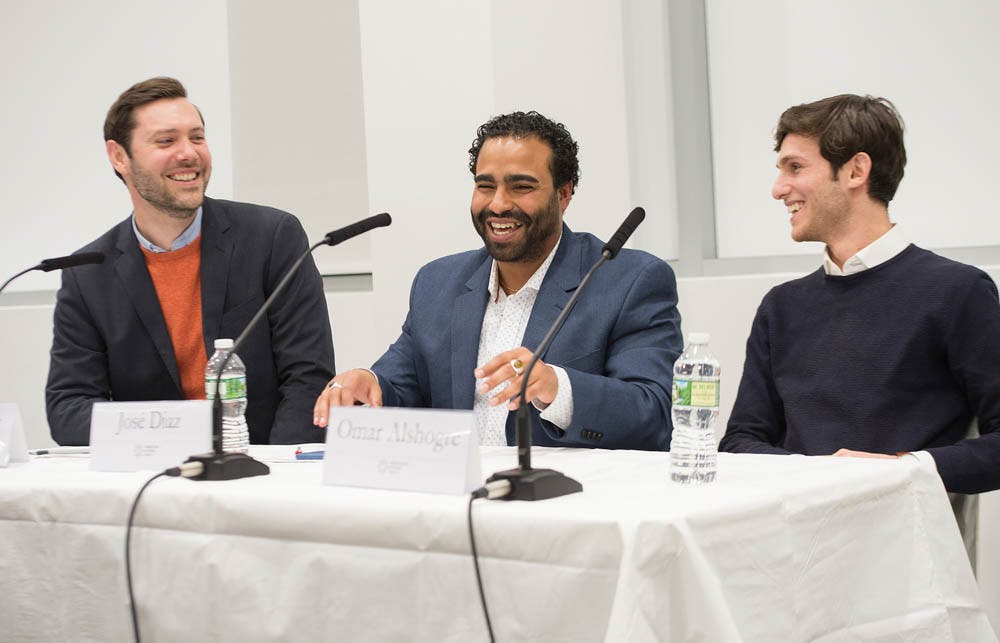For former Syrian political prisoner Omar Alshogre, the experience of looking into a mirror after his release from prison was shocking — he was unrecognizable to himself, with bloodshot eyes and weighing just 75 pounds. Alshogre was imprisoned in 2012 at the age of 15, and he spent the next three years shuffled from prison to prison in Syria, eventually ending up at the infamous Sednaya military prison, near Damascus. He was released three years later, after his mother paid a bribe to an army official.
Alshogre, along with Jose Diaz, a student at New York University who was incarcerated for 11 years at various prisons in New York, spoke Tuesday night at an event entitled “Critical Conversations: Experiences of Incarceration in the United States and Syria,” which was organized by Students Organizing for Syria and the Brown Middle East Studies Department. The event took place in the new Stephen Robert ‘62 P’91 Hall and was moderated by Visiting Assistant Professor of Middle Eastern Studies Alex Winder.
At the event, Alshogre and Diaz shared their stories.
Alshogre recounted his family life in northern Syria before demonstrations against the Bashar al-Assad regime began in 2011. While he had a relatively peaceful childhood, the demonstrations transformed his future. After he and his friends and family chose to participate in the protests, he was arrested for the first of seven times.
“I knew before … if you are in prison, you are one of the bad guys,” he said. “I can’t imagine a prisoner being a good guy. But when they put me in prison, I know that I am a good guy.” When officials began torturing him, he understood “that they are not a good guy. They are not good, now they are the people who kill us. That’s why we need a revolution.”
When Alshogre eventually reached Sednaya, he found that the prisoners were not allowed to talk, or else they faced torture. So instead they whispered, telling each other about themselves, what they did and who they were.
“I want to talk. I want to whisper,” Alshogre said, so the prisoners “created a university, the university of whispers.”
In Sednaya, Alshogre was assigned to write numbers on the bodies of prisoners who died while in prison, often due to poor conditions and torture.
The guards would ask, “How many dead bodies do you have today?”
For Alshogre and his cellmates, there was only ever one answer. More.
“And the numbers just kept going up,” Alshogre said.
He told of how the guards would force prisoners to torture and kill one another, and that they were always hungry. He said it was a dream to die full in prison.
He explained that torture was actually key to survival for him, “because if you sit down you’re going to die. In torture, you get to move.”
“Three years in prison is quite some time,” Alshogre said. “It’s not like being in Providence or at Brown University, because every minute is a hundred years. You can see everything, you can feel everything. How difficult it is. People dying every single hour. We have dead bodies everywhere.”
Once Alshogre was released from prison, he travelled first to Turkey and then eventually to Sweden, where he received medical assistance for his tuberculosis — which he caught in prison — and later, an education.
Now, Alshogre lives in Sweden and works for the Boston Consulting Group. He tells his story to audiences across the world.
Diaz also spoke about his experience with incarceration, but in the United States.
Diaz was imprisoned in 2005 at the age of 19 after killing a man in a gang fight. Eventually, he joined a prison-to-college pipeline program through Cornell that led him to a Bachelor of Arts/Master of Art track at New York University, where he is currently majoring in Latino Studies and Social and Cultural Analysis.
Diaz read aloud a short story he had written about his experience with imprisonment, called “Doors.” The story recounted both the experience of being in prison and the way prison severs connections with people outside the prison system.
“We’re here not as tokens to share a story… but as accomplices in the struggle,” he said of the multifaceted aspect of the event, with Alshogre sharing his experiences in Syria and Diaz in the United States.
Mahmoud Nowar, an audience member who has also survived Syrian prisons, said that to compare Syrian prisons with American ones was to normalize prisons in Syria. Instead, he said that they are more similar to concentration camps than to prisons.
“It’s not about competition of suffering. It’s not about who suffered more. It’s about extending our awareness of what a human can be,” said Nour Audi GS, a second-year graduate student in Brown’s Master of Public Health program and an SOS organizer.
“It’s extremely difficult to put these two experiences side by side. It’s more about getting people to relate to other people. It’s about diverse perspectives,” said Samy Amkieh ’21, also an SOS member.
Winder said that students drove the planning and organizing of the event, and they aimed to draw a diverse audience of undergraduate students and academics. Providing a contrast between Syria and the United States was a way of making the event “accessible,” he said, allowing the audience “to think more broadly about what the experience of incarceration is.”
Both men were full of optimism and excitement for life in their talks. Both say prison changed them.
“The most important and powerful and best experience I had in my life was prison,” Alshogre said. “I survived because I was in prison.”





